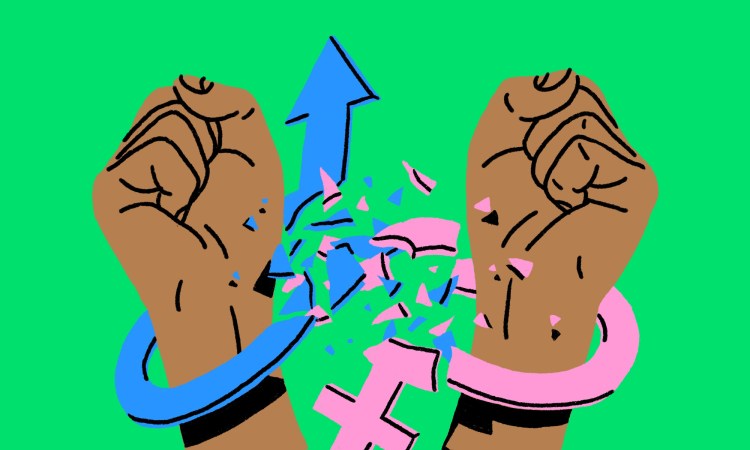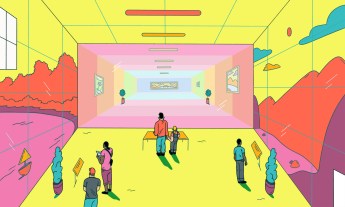
We call young people who step outside gender lines “brave.” But if adults truly want to support them, we need to be willing to show some courage and embrace some discomfort, say Michele Yulo and Audrey Mason-Hyde.
“When we find out that someone is having a baby, what is the very first question we ask? ‘Boy or girl?’” says Michele Yulo in a talk given at TEDxUtica. Beginning with the blue or pink wallpaper and continuing to trucks or dolls, this distinction sets children on separate gender paths that can shape much of their lives. But does it need to? Or, are there ways in which we can offer kids more freedom to discover who they are? Below, Yulo and teenager Audrey Mason-Hyde offer their suggestions.
When Michele Yulo’s daughter Gabby first learned to walk and talk, she didn’t show any interest in so-called “girly” things. “In fact,” says Yulo, the Atlanta-based founder of kids’ clothing brand Princess Free Zone, “she didn’t want to be anything like me; she wanted to be more like my husband.”
Yulo made a conscious decision to support Gabby’s preferences, and, when possible, not restrict her from doing and wearing what she wanted. For Yulo, a turning point came when Gabby was seven.
“She already had short hair. One day she said to me, ‘Mom, if boys can have a buzz cut, why can’t girls?’” recalls Yulo. “And there was nothing I could say to that. She was absolutely right; it was her hair, it was her choice. I did say to her, ‘Gabby, if you buzz your hair, I just want you to know people might look at you funny.’” But Gabby told her mother she was fine with that, so they went out to get her a buzz cut.
The result was worth it, says Yulo. “Gabby could not have been happier, and I knew right at that moment that allowing her to walk out into the world how she wanted to walk out into the world was what mattered.”
How can we translate this to the kids in our own lives? Adults need to learn to embrace them and their choices, according to Yulo. “Sometimes, kids who step outside gender lines are viewed as courageous, but I don’t believe that kids should have to be brave to be who they are. As parents, we have to be.”
This means standing up for them in public when they go against the stereotypes. For example, when Yulo and her family went to Disney World, a hotel employee asked Yulo: Was Gabby her little prince?
Yulo’s response: “No, and she’s not a princess either.’”
However, this doesn’t mean that children can’t enjoy the things they’re naturally drawn to. But we should think about when, where and how we may be directing them to fit the norms. Yulo recalls feeling her heart sink on seeing parents shoo their girls away from the boys’ clothing aisles where she and Gabby were browsing.
It’s easy to think, “What’s the big deal? Our kids have plenty of time to make their own choices when they’re grownups.” But childhood is when so many of our beliefs and self-conceptions are formed, work that it’s much harder to undo later. As Yulo says, “The reality is that these stereotypes set in and attach themselves like a second skin that will follow a child all the way through adulthood.”
Ultimately, this comes down to the aspirations that we hold for our children. Yulo asks, “We have the capability as parents to open up their worlds so that they truly have endless opportunities from which to choose. Isn’t that what we all want for our kids?”
And if we’re truly interested in expanding the possibilities for all children — not just the ones we know well — we need to look at how we handle our casual interactions. In a 2017 TEDxAdelaide talk, Audrey Mason-Hyde, then 12 years old, speaks openly about how strangers can unwittingly impose on one’s personal freedom. “In my experience, one of the first things people do is assume I’m a boy, or aren’t sure whether I’m a girl or a boy.”
Audrey’s distinctive style includes suits, bow ties, and flamingo socks. Exploring the world through fashion and clothing has been key to Audrey’s relationship with gender. “Until about the age of nine, when someone mistook me for a boy, I would reply comfortably that I’m a girl,” says Audrey. “But eventually, it stopped feeling right; instead of gaining confidence the more it happened, I lost it. ‘Girl’ didn’t feel right, but ‘boy’ didn’t feel correct either.”
Now 14, Audrey identifies as non-binary, or just simply Audrey (and uses the pronouns they/them). But this comes with some unexpected complications in public spaces. “I remember one of my first days at school, and I was in the girls’ toilet when two girls I knew came near me and said, ‘Look, there’s a boy in here,’” Audrey recalls. “I looked over my shoulder, but there was no one there. So I asked them, ‘Where?’ I realized they meant me. I was really shocked, as I’d only been around people who knew and understood me. I felt upset and alienated.”
Similar incidents happened in restrooms outside school. Audrey says, “Often, I would get things like ‘Why are you in here?’ or ‘Wrong bathroom.’ This eventually led to me being hesitant and tentative about even going to the bathroom in public.”
These experiences made Audrey only more determined to be themselves. Audrey says, “I’ve realized that, for me, gender is a spectrum. What my gender expression and identity is, is entirely about me and not about how other people perceive me.”
For Audrey, having to think hard about which toilets to use and how people may respond is stressful and a bit dehumanizing. Audrey says, “Using the girls’ toilets, I never feel good, and I still have a tendency to go with someone else. Though I’m not labeled as a particular gender when I go to the disabled toilets, I don’t feel great still, because it just reminds me that there are mostly no toilets for people like me, who don’t identify within the gender binary, and that toilets are just another way we categorize people.”
So, what should we do when find ourselves in a bathroom with someone who has a gender identity that we can’t quite place? Audrey’s advice: Accept not knowing.
Audrey says, “Would it hurt you not to know someone’s gender? Despite how uncomfortable it might make you feel, you assuming my gender makes me feel uncomfortable every day. All I’m asking is for you to just sit with that little bit of uncomfortable to make someone else feel better.”
This post is part of TED’s “How to Be a Better Human” series, each of which contains a piece of helpful advice from someone in the TED community; browse through all the posts here.
Watch Michele Yulo’s TEDxUtica talk now:
Watch Audrey Mason-Hyde’s TEDxAdelaide talk now:

















